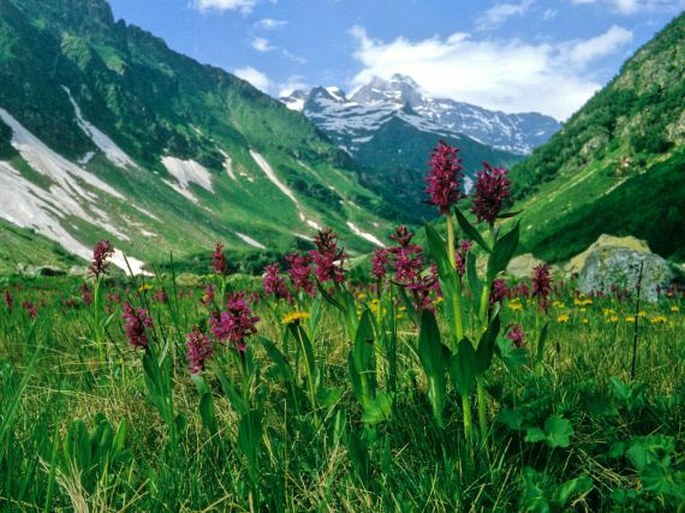Syn.: Dactylorhiza cataonica subsp. caucasica (Klinge) Soó, Dactylorhiza majalis subsp. caucasica (Klinge) H. Sund., Orchis caucasica (Klinge) Medw., nom. illeg., Orchis cordigera var. caucasica (Klinge) Klinge, Orchis monticola subsp. caucasica Klinge
Family: Orchidaceae Juss.

Distribution: Main Caucasus range from massifs above Sochi in Russia eastwards to Mt. Şahdağ region in eastern Azerbaijan; in scattered populations probably also in higher mountain ranges of Transcaucasia.
Ecology: Alpine or subalpine meadows, usually wet or at least moist, open brook source areas and marshy places; from 1500 to 3000 m asl. Blooms from June to July.

Description: Usually short tuberose orchid of rather compact habit, 15–30 cm tall. Stem erect, relatively stout, often purplish below the inflorescence, with mostly 5–6 leaves almost regularly arranged. Leaves of almost equal length and shape except the lowest and uppermost, (3.5–)5–8(–11) cm long; main leaves ovate or subovate with acute or obtuse tip, sometimes broadly lanceolate, bright green, constantly unspotted throughout typical (non-hybrid) populations. Inflorescence shortly and densely cylindrical, with purplish bracts, exceeding the lower flowers. Flowers deep purple with somewhat whitish lip mouth; lip 9–16 mm wide and 8–13 mm long, almost undivided but marginally erose and tipped, or with three lobes of which the middle is small, triangular and almost entire, the two lateral are irregularly roundish or rhomboidal and usually with an erose outer margin; lips and sepals inside with dark, incontrast spot ornaments or spots; spur saccate, obtuse, 7–15 mm long, somewhat shorter than ovary. The fruit is a capsule.
Threat and protection: This species – like all species of the family Orchidaceae – is included in the list of species protected by CITES.
Note: This species was usually confused with Dactylorhiza euxina from which easily distinguishes by constantly unspotted, relatively broader and shorter leaves. For the reason of confusions the distribution range of both species is partly unknown. Distribution of both species surely overlaps in middle part of the main Caucasus range north of Tbilisi, but distribution of the pure D. caucasica populations in Transcaucasia (Caucasus Minor range in southern Georgia and Armenia) and in the northeastern corner of Turkey is uncertain.







These images were taken in Russia, Caucasus, above Krasnaya Polyana in the Sochi region, 2100 m asl. (July 1993); Azerbaijan, Mt. Şahdağ (July 2002); albinotic form in Georgia, Adange Pass region, 2600 m asl. (July 1987).


